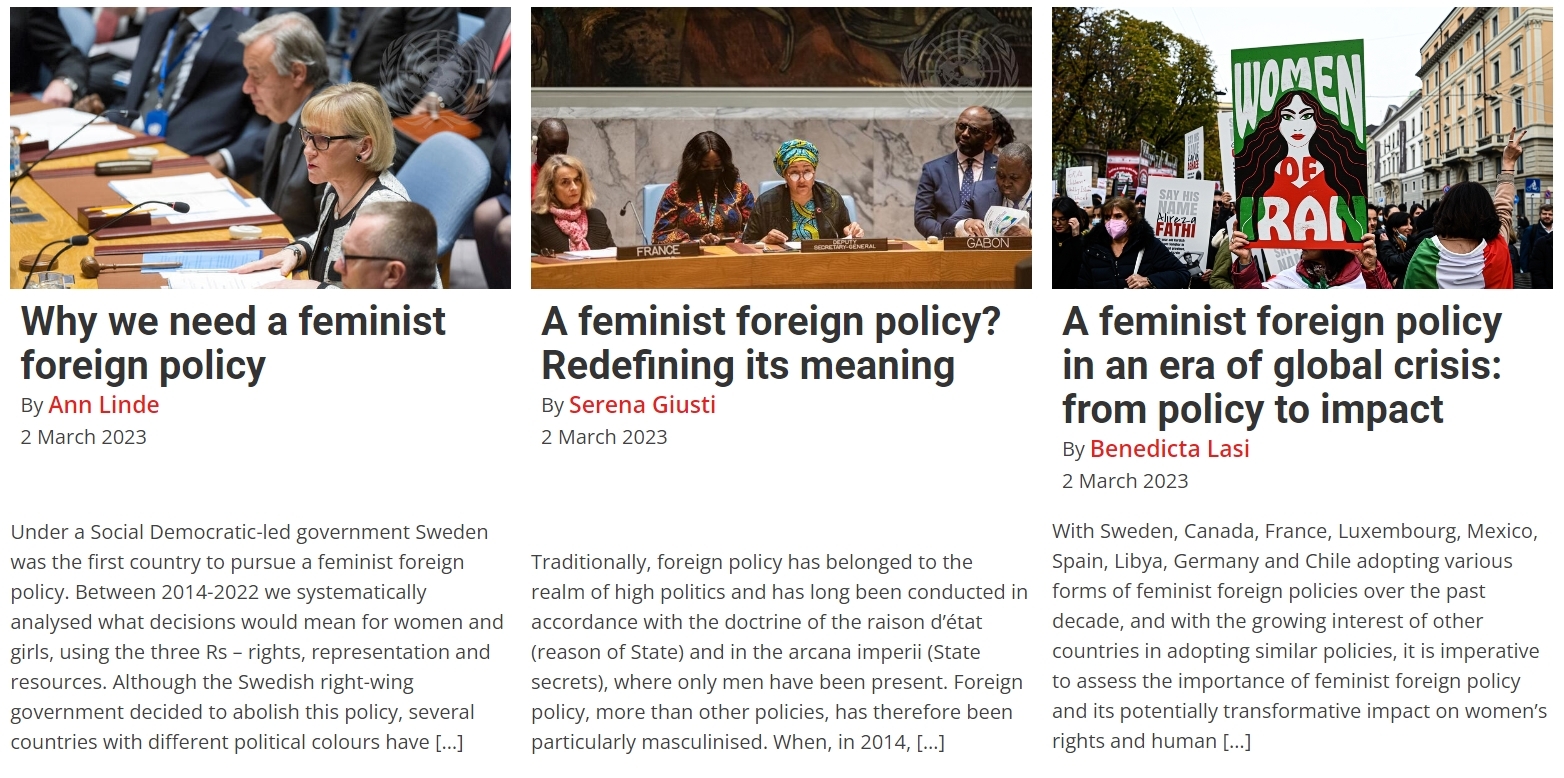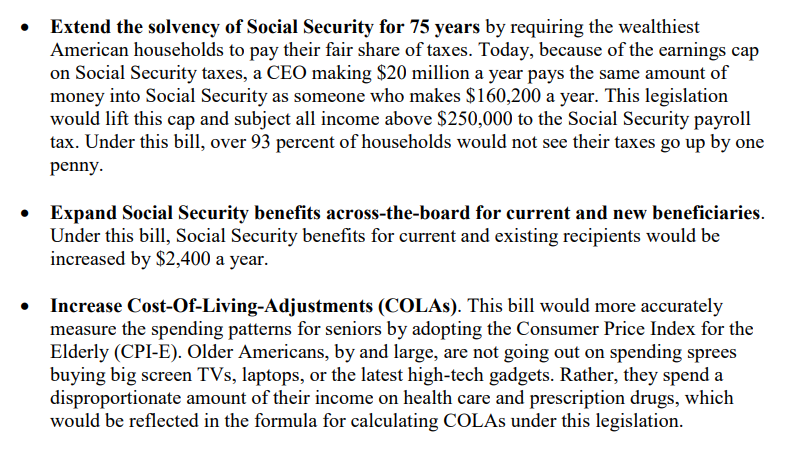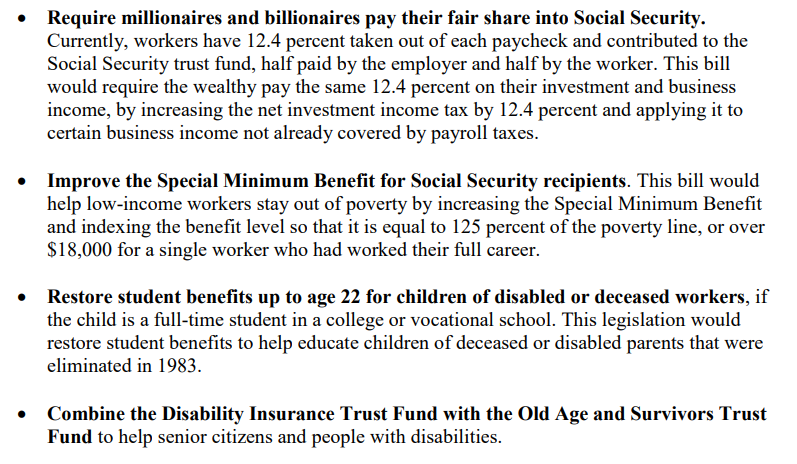Welcome to DU!
The truly grassroots left-of-center political community where regular people, not algorithms, drive the discussions and set the standards.
Join the community:
Create a free account
Support DU (and get rid of ads!):
Become a Star Member
Latest Breaking News
General Discussion
The DU Lounge
All Forums
Issue Forums
Culture Forums
Alliance Forums
Region Forums
Support Forums
Help & Search
Celerity
Celerity's Journal
Celerity's Journal
March 3, 2023

https://progressivepost.eu/dossier/what-does-feminist-foreign-policy-mean-for-progressives/


Dossier: ♀️What does feminist foreign policy mean for progressives?

https://progressivepost.eu/dossier/what-does-feminist-foreign-policy-mean-for-progressives/
On Wednesday 1 March, a week before International Women’s Day, the centre-left German government announced the guidelines for the pursuit of its new feminist foreign policy. But what does exactly a feminist foreign policy entail? What potential does it offer? What are its likely criticalities? And what are the challenges that lie ahead?
In this new dossier, the Progressive Post explores this concept of feminist foreign policy – the contours of which still need to be fully outlined. It is already clear, however, that feminist foreign policy implies ensuring the respect of women’s rights, as well as the active participation of women in the decision-making process, rather than them simply being on the receiving end of policies. It also involves the adoption of a gender lens when dealing with human rights, peace, security, development and trade. Yet we must neither oversimplify feminist foreign policy by thinking that it is only a question of perspective, nor must we reinforce stereotypes about women’s approach to security. The final goal of feminist foreign policy, in fact, must be to shape policies differently while at the same time addressing inequalities and changing power structures – goals that are deeply engraved in the progressives’ agenda.
In this new dossier, the Progressive Post explores this concept of feminist foreign policy – the contours of which still need to be fully outlined. It is already clear, however, that feminist foreign policy implies ensuring the respect of women’s rights, as well as the active participation of women in the decision-making process, rather than them simply being on the receiving end of policies. It also involves the adoption of a gender lens when dealing with human rights, peace, security, development and trade. Yet we must neither oversimplify feminist foreign policy by thinking that it is only a question of perspective, nor must we reinforce stereotypes about women’s approach to security. The final goal of feminist foreign policy, in fact, must be to shape policies differently while at the same time addressing inequalities and changing power structures – goals that are deeply engraved in the progressives’ agenda.


March 2, 2023






The Abrahamic Family House, an interfaith complex designed by architect David Adjaye that contains a church, a synagogue and a mosque, has opened in Abu Dhabi. Located on Saadiyat Island – a cultural hub positioned off the coast of Abu Dhabi – the project incorporates three separate houses of worship for the three Abrahamic religions Christianity, Judaism and Islam.





The Abrahamic Family House is made up of a trio of standalone cubic buildings with flat roofs, each equal in volume but distinguished by their own features including differently sized courtyards. "Each building's architectural articulation is unique, and specifically oriented to its siting and religious references," said the architect, who founded his eponymous firm Adjaye Associates in 2000.





His Holiness Francis Church is characterised by a facade of towering Omani limestone columns that are positioned from east to west to enhance morning sunlight on the interior, referencing light as a symbol of divinity in Christianity. Inside, a cluster of linear timber battens are suspended from the ceiling. These were designed to evoke the notion of "a shower of ecstatic redemption", according to the architecture studio. Light filters through the octagonally-shaped baptistry.





Other design elements within the church include geometric pews formed from traditional hard-wearing oak and a purposefully minimal central crucifix that aims to welcome worshippers from all denominations. A suspended bronze mesh tent descends from a central skylight inside, echoing the tent-like structure of sukkahs already referenced on the exterior, as well as the original tabernacle.
snip












Adjaye Associates unveils Abrahamic Family House interfaith complex in Abu Dhabi
https://www.dezeen.com/2023/02/23/david-adjaye-abrahamic-family-house-interfaith-complex/





The Abrahamic Family House, an interfaith complex designed by architect David Adjaye that contains a church, a synagogue and a mosque, has opened in Abu Dhabi. Located on Saadiyat Island – a cultural hub positioned off the coast of Abu Dhabi – the project incorporates three separate houses of worship for the three Abrahamic religions Christianity, Judaism and Islam.





The Abrahamic Family House is made up of a trio of standalone cubic buildings with flat roofs, each equal in volume but distinguished by their own features including differently sized courtyards. "Each building's architectural articulation is unique, and specifically oriented to its siting and religious references," said the architect, who founded his eponymous firm Adjaye Associates in 2000.





His Holiness Francis Church is characterised by a facade of towering Omani limestone columns that are positioned from east to west to enhance morning sunlight on the interior, referencing light as a symbol of divinity in Christianity. Inside, a cluster of linear timber battens are suspended from the ceiling. These were designed to evoke the notion of "a shower of ecstatic redemption", according to the architecture studio. Light filters through the octagonally-shaped baptistry.





Other design elements within the church include geometric pews formed from traditional hard-wearing oak and a purposefully minimal central crucifix that aims to welcome worshippers from all denominations. A suspended bronze mesh tent descends from a central skylight inside, echoing the tent-like structure of sukkahs already referenced on the exterior, as well as the original tabernacle.
snip












March 2, 2023

https://progressivepost.eu/dossier/what-does-feminist-foreign-policy-mean-for-progressives/


Dossier: ♀️What does feminist foreign policy mean for progressives?

https://progressivepost.eu/dossier/what-does-feminist-foreign-policy-mean-for-progressives/
On Wednesday 1 March, a week before International Women’s Day, the centre-left German government announced the guidelines for the pursuit of its new feminist foreign policy. But what does exactly a feminist foreign policy entail? What potential does it offer? What are its likely criticalities? And what are the challenges that lie ahead?
In this new dossier, the Progressive Post explores this concept of feminist foreign policy – the contours of which still need to be fully outlined. It is already clear, however, that feminist foreign policy implies ensuring the respect of women’s rights, as well as the active participation of women in the decision-making process, rather than them simply being on the receiving end of policies. It also involves the adoption of a gender lens when dealing with human rights, peace, security, development and trade. Yet we must neither oversimplify feminist foreign policy by thinking that it is only a question of perspective, nor must we reinforce stereotypes about women’s approach to security. The final goal of feminist foreign policy, in fact, must be to shape policies differently while at the same time addressing inequalities and changing power structures – goals that are deeply engraved in the progressives’ agenda.
In this new dossier, the Progressive Post explores this concept of feminist foreign policy – the contours of which still need to be fully outlined. It is already clear, however, that feminist foreign policy implies ensuring the respect of women’s rights, as well as the active participation of women in the decision-making process, rather than them simply being on the receiving end of policies. It also involves the adoption of a gender lens when dealing with human rights, peace, security, development and trade. Yet we must neither oversimplify feminist foreign policy by thinking that it is only a question of perspective, nor must we reinforce stereotypes about women’s approach to security. The final goal of feminist foreign policy, in fact, must be to shape policies differently while at the same time addressing inequalities and changing power structures – goals that are deeply engraved in the progressives’ agenda.


March 1, 2023

Since 2000, the annual Bilan social volume has analysed the state of play of social policy in the European Union during the preceding year, the better to forecast developments in the new one. Co-produced by the European Social Observatory (OSE) and the European Trade Union Institute (ETUI), the new edition is no exception. In the context of multiple crises, the authors find that social policies gained in terms of ambition in 2022. At the same time, the new EU economic framework, expected for 2023, should be made compatible with achieving the EU’s social and ‘green’ objectives. Finally, they raise the question whether the Social Imbalances Procedure (SIP) and the Open Strategic Autonomy (OSA) paradigm could provide windows of opportunity to sustain the EU’s social ambition in the long run.
The EU’s annual rate of inflation was 9.6 per cent in June 2022; a year earlier, it was just 2.2 per cent. Unleashed in February 2022, the war in Ukraine has put paid to Europe’s fragile economic recovery from the Covid-19 pandemic, triggering a devastating humanitarian crisis in Europe and sharp rises in food and energy prices, exacerbating global inflationary pressures. Despite this stormy background, the EU social ship has reached deeper waters. With the wind of the European Pillar of Social Rights in its sails, important progress has been made on areas including minimum wages, occupational health and safety, the terms and conditions of people working via platforms and gender equality. Furthermore, many social initiatives have seen the light of day under the umbrella of the Recovery and Resilience Facility, promoting social investment, performance-based financing and a just transition that is also green, albeit this has been patchy.
The need for a reform of EU governance to promote social progress and the setting up of a SIP
On November 9th 2022, the European Commission published a communication illustrating its orientation on a reformed framework of EU economic governance. Such a reform should, however, be accompanied by a significant strengthening of the EU’s social dimension, argue the editors of the Bilan social. As illustrated in the aftermath of the Great Recession, the asymmetry between relatively strong and well-codified EU governance procedures in the fiscal and macroeconomic domains and weaker procedures in the social one represents a threat to social policy in Europe. In this respect, the setting up in 2023 of a so-called EU ‘Social Imbalances Procedure’ (SIP) would be a promising step forward. With the upcoming launch of a pilot scheme to test the practical modalities of such an instrument, a window of opportunity is open. The first months of 2023 will be crucial in avoiding the risk of a watered-down tool which has neither the ambition nor the strength to counterbalance EU fiscal and macroeconomic instruments.
The OSA: a new framework for sustaining an ambitious EU social agenda in a context of permacrisis
According to the editors, the time is now right to seize the EU’s Open Strategic Autonomy as a window of opportunity for sustaining the EU’s social ambitions. After all, in their strategic agenda for the EU in 2019-24, the heads of state and government did pave the way for a broader notion of strategic autonomy, leading to the European Commission picking up the gauntlet and proposing a much broader paradigm. In June 2022, the ETUC called for an ambitious agenda on OSA, acknowledging it as ‘one of the promising avenues to re-establish a fair and level playing field for a resilient economy, in full respect of EU democratic, social and environmental values’. Such an expanded vision may provide an opportunity for national and European social players to influence the policy agenda, especially through dialogue with the European institutions.
Social policy in the European Union: state of play 2022 - Policymaking in a permacrisis (free PDF)

Since 2000, the annual Bilan social volume has analysed the state of play of social policy in the European Union during the preceding year, the better to forecast developments in the new one. Co-produced by the European Social Observatory (OSE) and the European Trade Union Institute (ETUI), the new edition is no exception. In the context of multiple crises, the authors find that social policies gained in terms of ambition in 2022. At the same time, the new EU economic framework, expected for 2023, should be made compatible with achieving the EU’s social and ‘green’ objectives. Finally, they raise the question whether the Social Imbalances Procedure (SIP) and the Open Strategic Autonomy (OSA) paradigm could provide windows of opportunity to sustain the EU’s social ambition in the long run.
The EU’s annual rate of inflation was 9.6 per cent in June 2022; a year earlier, it was just 2.2 per cent. Unleashed in February 2022, the war in Ukraine has put paid to Europe’s fragile economic recovery from the Covid-19 pandemic, triggering a devastating humanitarian crisis in Europe and sharp rises in food and energy prices, exacerbating global inflationary pressures. Despite this stormy background, the EU social ship has reached deeper waters. With the wind of the European Pillar of Social Rights in its sails, important progress has been made on areas including minimum wages, occupational health and safety, the terms and conditions of people working via platforms and gender equality. Furthermore, many social initiatives have seen the light of day under the umbrella of the Recovery and Resilience Facility, promoting social investment, performance-based financing and a just transition that is also green, albeit this has been patchy.
The need for a reform of EU governance to promote social progress and the setting up of a SIP
On November 9th 2022, the European Commission published a communication illustrating its orientation on a reformed framework of EU economic governance. Such a reform should, however, be accompanied by a significant strengthening of the EU’s social dimension, argue the editors of the Bilan social. As illustrated in the aftermath of the Great Recession, the asymmetry between relatively strong and well-codified EU governance procedures in the fiscal and macroeconomic domains and weaker procedures in the social one represents a threat to social policy in Europe. In this respect, the setting up in 2023 of a so-called EU ‘Social Imbalances Procedure’ (SIP) would be a promising step forward. With the upcoming launch of a pilot scheme to test the practical modalities of such an instrument, a window of opportunity is open. The first months of 2023 will be crucial in avoiding the risk of a watered-down tool which has neither the ambition nor the strength to counterbalance EU fiscal and macroeconomic instruments.
The OSA: a new framework for sustaining an ambitious EU social agenda in a context of permacrisis
According to the editors, the time is now right to seize the EU’s Open Strategic Autonomy as a window of opportunity for sustaining the EU’s social ambitions. After all, in their strategic agenda for the EU in 2019-24, the heads of state and government did pave the way for a broader notion of strategic autonomy, leading to the European Commission picking up the gauntlet and proposing a much broader paradigm. In June 2022, the ETUC called for an ambitious agenda on OSA, acknowledging it as ‘one of the promising avenues to re-establish a fair and level playing field for a resilient economy, in full respect of EU democratic, social and environmental values’. Such an expanded vision may provide an opportunity for national and European social players to influence the policy agenda, especially through dialogue with the European institutions.
Download here, in French or English

Table of contents
01__The war in Ukraine and the future of the EU prospects for reform
02__Steering national social reforms through the EU's recovery plan
03__The socio-ecological dimension of the EU’s recovery further traction for the European Green Deal
04__The politics behind EU legislation on platform work institutional synergies and a novel constellation of players
05__The EU Gender Equality Strategy 2020-2025 the beginning of a new season
06__The rule of law crisis and social policy the EU response in the cases of Hungary and Poland
07__Policymaking in a state of permacrisis can the EU uphold its social ambitions
08__The European Union in 2021 key events
At the beginning of 2022, hopes were high that the Covid-19 pandemic was on the ebb and that the European Union (EU) would be able to focus again on the main challenge of this century: how to proactively tackle the green and digital transition in a socially fair and inclusive way. But the Russian invasion of Ukraine dashed these hopes. Realpolitik was back on the agenda, with the EU having to figure out how to deal with its Eastern neighbour. Overnight, EU dependence on Russian fossil fuels became a major headache. With energy and food prices soaring, double-digit inflation reared its ugly head throughout the world, resulting in a cost-of-living crisis which has pushed millions of people into poverty as well as stoking popular discontent and mobilising trade unions, with the prospect of further civil unrest, protests and strikes. Obviously, all this had a major influence on EU policymaking: while the Russian military aggression in early 2022 prompted the EU to respond with unprecedented steps forward in European integration, it also highlighted the weaknesses in the EU governance system. A health crisis, an economic and financial crisis and a climate crisis are unfolding in parallel, while full-scale war is back in Europe. The question is now whether ‘normal times’ will ever return or whether we will find ourselves living in a state of ‘permacrisis’.
Despite this stormy background, the EU social ship reached deeper waters. With the wind of the European Pillar of Social Rights in its sails, important progress has been made inter alia on minimum wages, occupational health and safety, the working conditions of people working through platforms, and gender equality. Furthermore, many new social initiatives have seen the light of day under the umbrella of the Recovery and Resilience Facility, promoting, at least to some extent, social investment, performance-based financing and (be it in a patchy way) a ‘just’ green transition. Last but not least, the pandemic and the war in Ukraine have furthered European integration through highlighting the need to stand together in the face of a common foe. A European health space is now in the making, and new forms of economic governance – including the scope for an EU Social Imbalances Procedure – are being discussed, while the debate about a minimum income initiative is ongoing. Finally, this year’s Bilan social raises the question whether the EUs ‘open strategic autonomy’ paradigm could provide a window of opportunity to sustain the EU’s social ambitions in the longer run.

Table of contents
01__The war in Ukraine and the future of the EU prospects for reform
02__Steering national social reforms through the EU's recovery plan
03__The socio-ecological dimension of the EU’s recovery further traction for the European Green Deal
04__The politics behind EU legislation on platform work institutional synergies and a novel constellation of players
05__The EU Gender Equality Strategy 2020-2025 the beginning of a new season
06__The rule of law crisis and social policy the EU response in the cases of Hungary and Poland
07__Policymaking in a state of permacrisis can the EU uphold its social ambitions
08__The European Union in 2021 key events
At the beginning of 2022, hopes were high that the Covid-19 pandemic was on the ebb and that the European Union (EU) would be able to focus again on the main challenge of this century: how to proactively tackle the green and digital transition in a socially fair and inclusive way. But the Russian invasion of Ukraine dashed these hopes. Realpolitik was back on the agenda, with the EU having to figure out how to deal with its Eastern neighbour. Overnight, EU dependence on Russian fossil fuels became a major headache. With energy and food prices soaring, double-digit inflation reared its ugly head throughout the world, resulting in a cost-of-living crisis which has pushed millions of people into poverty as well as stoking popular discontent and mobilising trade unions, with the prospect of further civil unrest, protests and strikes. Obviously, all this had a major influence on EU policymaking: while the Russian military aggression in early 2022 prompted the EU to respond with unprecedented steps forward in European integration, it also highlighted the weaknesses in the EU governance system. A health crisis, an economic and financial crisis and a climate crisis are unfolding in parallel, while full-scale war is back in Europe. The question is now whether ‘normal times’ will ever return or whether we will find ourselves living in a state of ‘permacrisis’.
Despite this stormy background, the EU social ship reached deeper waters. With the wind of the European Pillar of Social Rights in its sails, important progress has been made inter alia on minimum wages, occupational health and safety, the working conditions of people working through platforms, and gender equality. Furthermore, many new social initiatives have seen the light of day under the umbrella of the Recovery and Resilience Facility, promoting, at least to some extent, social investment, performance-based financing and (be it in a patchy way) a ‘just’ green transition. Last but not least, the pandemic and the war in Ukraine have furthered European integration through highlighting the need to stand together in the face of a common foe. A European health space is now in the making, and new forms of economic governance – including the scope for an EU Social Imbalances Procedure – are being discussed, while the debate about a minimum income initiative is ongoing. Finally, this year’s Bilan social raises the question whether the EUs ‘open strategic autonomy’ paradigm could provide a window of opportunity to sustain the EU’s social ambitions in the longer run.
March 1, 2023
related
FBI director says China lab leak likely caused COVID pandemic
https://www.reuters.com/business/healthcare-pharmaceuticals/fbi-director-says-china-lab-leak-likely-caused-covid-pandemic-2023-03-01/
March 1, 2023 3:30 AM GMT+1
WASHINGTON (Reuters) - FBI Director Christopher Wray said on Tuesday the agency has assessed that a leak from a laboratory in Wuhan, China, likely caused the COVID-19 pandemic.
"The FBI has for quite some time now assessed that the origins of the pandemic are most likely a potential lab incident in Wuhan," Wray told Fox News. His comments follow a Wall Street Journal report on Sunday that the U.S. Energy Department has assessed with low confidence the pandemic resulted from an unintended lab leak in China.
Four other agencies, along with a national intelligence panel, still judge that the pandemic was likely the result of a natural transmission, and two are undecided, the Journal reported.
White House national security spokesman John Kirby said on Monday the U.S. government has not reached a definitive conclusion and consensus on the pandemic's origins.
snip
March 1, 2023 3:30 AM GMT+1
WASHINGTON (Reuters) - FBI Director Christopher Wray said on Tuesday the agency has assessed that a leak from a laboratory in Wuhan, China, likely caused the COVID-19 pandemic.
"The FBI has for quite some time now assessed that the origins of the pandemic are most likely a potential lab incident in Wuhan," Wray told Fox News. His comments follow a Wall Street Journal report on Sunday that the U.S. Energy Department has assessed with low confidence the pandemic resulted from an unintended lab leak in China.
Four other agencies, along with a national intelligence panel, still judge that the pandemic was likely the result of a natural transmission, and two are undecided, the Journal reported.
White House national security spokesman John Kirby said on Monday the U.S. government has not reached a definitive conclusion and consensus on the pandemic's origins.
snip
related
Covid Likely Originated From Lab Leak, Energy Department Reportedly Finds—But Biden Aide Says There’s No ‘Definitive Answer’
https://www.forbes.com/sites/marisadellatto/2023/02/26/covid-likely-originated-from-lab-leak-energy-department-reportedly-finds-but-biden-aide-says-theres-no-definitive-answer/
snip
KEY FACTS
The Energy Department’s new conclusions are found in an updated classified report from the office of Avril Haines, the Director of National Intelligence, which was recently provided to the White House and some members of Congress, according to the Journal.
The Energy Department, which oversees many U.S. laboratories, came to its conclusion based on new intelligence, but deemed its level of confidence in its judgment as “low,” people who read the report told the Journal.
The FBI also determined in 2021 with “moderate confidence” the virus came from a lab leak, but the agency came to its conclusion for different reasons than the Energy Department, U.S. officials told the Journal.
Other federal agencies disagree: Four agencies have reportedly determined with “low confidence” the virus was transmitted naturally through animals, and two others, including the CIA, remain undecided between the two origin theories.
CRUCIAL QUOTE
“Some elements of the intelligence community have reached conclusions on one side, some on the other, a number of them have said they just don't have enough information to be sure…President Biden has directed, repeatedly, every element of our intelligence community to put effort and resources behind getting to the bottom of this question,” Sullivan said on CNN on Sunday when asked about the Journal’s reporting. “But right now, there is not a definitive answer that has emerged from the intelligence community on this question.”
snip
https://www.forbes.com/sites/marisadellatto/2023/02/26/covid-likely-originated-from-lab-leak-energy-department-reportedly-finds-but-biden-aide-says-theres-no-definitive-answer/
snip
KEY FACTS
The Energy Department’s new conclusions are found in an updated classified report from the office of Avril Haines, the Director of National Intelligence, which was recently provided to the White House and some members of Congress, according to the Journal.
The Energy Department, which oversees many U.S. laboratories, came to its conclusion based on new intelligence, but deemed its level of confidence in its judgment as “low,” people who read the report told the Journal.
The FBI also determined in 2021 with “moderate confidence” the virus came from a lab leak, but the agency came to its conclusion for different reasons than the Energy Department, U.S. officials told the Journal.
Other federal agencies disagree: Four agencies have reportedly determined with “low confidence” the virus was transmitted naturally through animals, and two others, including the CIA, remain undecided between the two origin theories.
CRUCIAL QUOTE
“Some elements of the intelligence community have reached conclusions on one side, some on the other, a number of them have said they just don't have enough information to be sure…President Biden has directed, repeatedly, every element of our intelligence community to put effort and resources behind getting to the bottom of this question,” Sullivan said on CNN on Sunday when asked about the Journal’s reporting. “But right now, there is not a definitive answer that has emerged from the intelligence community on this question.”
snip
February 28, 2023
Plan for the worst and pray for the best with these student loans.

https://www.reckon.news/news/2023/02/student-loan-borrowers-could-be-forced-into-unthinkable-financial-decisions-if-supreme-court-rules-against-biden.html

Pinching pennies and starting a student loan debt repayment plan could soon be the reality for federal student loan borrowers. The U.S. Supreme Court will hear two arguments – one case from six Republican-led states and another brought by two borrowers in Texas coming up on Feb. 28. These cases could determine the fate of President Biden’s student loan forgiveness plan. If the high court strikes down the plan, borrowers will have to re-start repaying their federal student loans this year.
“Should payments resume this year, borrowers will be forced to make unthinkable financial decisions like whether or not they can save for retirement, start a family or put food on the table,” Braxton Brewington, press secretary of The Debt Collective, a debt-elimination advocacy group told Reckon. Nearly 26 million Americans who applied for relief are now in limbo, hoping justices will uphold Biden’s plan of canceling $10,000 to $20,000 in student loan forgiveness. If SCOTUS blocks the student loan forgiveness plan, determining next steps for repayment should be at the top of federal borrowers’ lists. Here are a few ideas to consider:
What to know about a repayment plan
Repaying student loan debt is different for every borrower, especially when more than 40 million Americans have benefitted from not having to pay on them for the past three years. A common option for borrowers before the pause was selecting an income-driven student loan repayment plan. By visiting StudentAid.gov or providing income verification to a loan servicer, federal student loan borrowers can set up a repayment plan based on their income.
With student loan payments set to start either 60 days after SCOTUS makes a decision, or 60 days after June 30 (when the pause ends), higher education experts like Mark Kantrowitz have told USA Today, “Sixty days will be enough to forgive student loan debt if the president’s plan survives.” In the event Biden’s forgiveness plan doesn’t survive, he has a newly proposed income-driven repayment plan. This plan is meant to prevent borrowers from getting overloaded with debt by either lowering monthly payments or effectively pausing them, making payments more affordable and manageable.
snip
Read more: ‘Student debt is morally illegitimate
Student loan borrowers could be forced into 'unthinkable financial decisions' if Supreme Court rules
against BidenPlan for the worst and pray for the best with these student loans.

https://www.reckon.news/news/2023/02/student-loan-borrowers-could-be-forced-into-unthinkable-financial-decisions-if-supreme-court-rules-against-biden.html

Pinching pennies and starting a student loan debt repayment plan could soon be the reality for federal student loan borrowers. The U.S. Supreme Court will hear two arguments – one case from six Republican-led states and another brought by two borrowers in Texas coming up on Feb. 28. These cases could determine the fate of President Biden’s student loan forgiveness plan. If the high court strikes down the plan, borrowers will have to re-start repaying their federal student loans this year.
“Should payments resume this year, borrowers will be forced to make unthinkable financial decisions like whether or not they can save for retirement, start a family or put food on the table,” Braxton Brewington, press secretary of The Debt Collective, a debt-elimination advocacy group told Reckon. Nearly 26 million Americans who applied for relief are now in limbo, hoping justices will uphold Biden’s plan of canceling $10,000 to $20,000 in student loan forgiveness. If SCOTUS blocks the student loan forgiveness plan, determining next steps for repayment should be at the top of federal borrowers’ lists. Here are a few ideas to consider:
What to know about a repayment plan
Repaying student loan debt is different for every borrower, especially when more than 40 million Americans have benefitted from not having to pay on them for the past three years. A common option for borrowers before the pause was selecting an income-driven student loan repayment plan. By visiting StudentAid.gov or providing income verification to a loan servicer, federal student loan borrowers can set up a repayment plan based on their income.
With student loan payments set to start either 60 days after SCOTUS makes a decision, or 60 days after June 30 (when the pause ends), higher education experts like Mark Kantrowitz have told USA Today, “Sixty days will be enough to forgive student loan debt if the president’s plan survives.” In the event Biden’s forgiveness plan doesn’t survive, he has a newly proposed income-driven repayment plan. This plan is meant to prevent borrowers from getting overloaded with debt by either lowering monthly payments or effectively pausing them, making payments more affordable and manageable.
snip
Read more: ‘Student debt is morally illegitimate
February 28, 2023
Social Security is one of the most popular and successful government programs in the history of our country. For more than 80 years, through good times and bad, Social Security has paid out every benefit owed to every eligible American on time and without delay. In 2021, Social Security lifted 26.3 million Americans out of poverty, including more than 18 million seniors. Before it was created in 1935, about half of our nation’s seniors were living in poverty. Today, the senior poverty rate is 10.3 percent. Yet, despite this success, tens of millions of seniors and 25 percent of people with disabilities are still struggling to get by, and many older workers fear that they will never be able to retire with security and dignity.
The most recent evidence indicates that nearly 40 percent of seniors rely on Social Security for a majority of their income and one in every seven seniors rely on it for more than 90 percent of their income. And to make matters worse, nearly half of Americans age 55 and older have no retirement savings. Meanwhile, the average Social Security benefit is only $1,688 a month. Social Security is not going broke. Social Security has a $2.85 trillion surplus in its trust fund and can pay every promised benefit to every eligible American until the year 2035. After that, the Social Security Administration estimates that there will be enough funding available to pay 80 percent of promised benefits. Given this reality, our job is not to cut Social Security, as many of our Republican colleagues in Congress want to do. Our job is to expand Social Security and extend its solvency so that everyone in America can retire with the respect that they have earned and deserve after a lifetime of hard work. That’s what the Social Security Expansion Act is all about.
snip
Social Security Expansion Act Fact Sheet
https://www.sanders.senate.gov/wp-content/uploads/Social-Security-Expansion-Act-one-pager-Final.pdfSocial Security is one of the most popular and successful government programs in the history of our country. For more than 80 years, through good times and bad, Social Security has paid out every benefit owed to every eligible American on time and without delay. In 2021, Social Security lifted 26.3 million Americans out of poverty, including more than 18 million seniors. Before it was created in 1935, about half of our nation’s seniors were living in poverty. Today, the senior poverty rate is 10.3 percent. Yet, despite this success, tens of millions of seniors and 25 percent of people with disabilities are still struggling to get by, and many older workers fear that they will never be able to retire with security and dignity.
The most recent evidence indicates that nearly 40 percent of seniors rely on Social Security for a majority of their income and one in every seven seniors rely on it for more than 90 percent of their income. And to make matters worse, nearly half of Americans age 55 and older have no retirement savings. Meanwhile, the average Social Security benefit is only $1,688 a month. Social Security is not going broke. Social Security has a $2.85 trillion surplus in its trust fund and can pay every promised benefit to every eligible American until the year 2035. After that, the Social Security Administration estimates that there will be enough funding available to pay 80 percent of promised benefits. Given this reality, our job is not to cut Social Security, as many of our Republican colleagues in Congress want to do. Our job is to expand Social Security and extend its solvency so that everyone in America can retire with the respect that they have earned and deserve after a lifetime of hard work. That’s what the Social Security Expansion Act is all about.
The Social Security Expansion Act would:




snip
February 27, 2023
https://www.nytimes.com/2023/02/27/business/student-loan-debt-supreme-court.html
https://archive.is/nZDr2

In September, Jason Doresky received a $10,000 direct deposit from the Education Department. It was a refund for payments he had made voluntarily on his federal student loans since March 2020, when the government told borrowers that they could stop paying temporarily because of the pandemic. Three years later, those loans are still on hold — and Mr. Doresky, 31, who graduated from the University of Kansas in 2015, still has the money he received sitting in his savings account, untouched. He’s waiting to find out if he’ll have to send it back.
On Tuesday, the Supreme Court will hear arguments about President Biden’s plan to eliminate up to $20,000 in federal student loan debt for most borrowers, at an estimated cost of $400 billion. Mr. Biden’s plan, announced in August, has been blocked by legal challenges, preventing the government from canceling any debt for the 26 million borrowers who have applied for relief. The White House insists its approach — which bypassed Congress and relies on a 2003 law, the HEROES Act, that allows the education secretary to grant relief in times of national emergency — is legally sound. The actions that Mr. Biden has directed Education Secretary Miguel Cardona to take “fall comfortably within the plain text of the act,” the administration argued in a legal filing to the court.

Jason Doresky received a $10,000 refund in September for payments he had made on his federal student loans since March 2020. He’s waiting to find out if he’ll have to send it back.
Challengers, including six Republican-led states, call it an abuse of executive authority that seeks “breathtaking and transformative power” by relying on “a tenuous and pretextual connection to a national emergency,” according to their legal brief. Caught in limbo are millions of borrowers, like Mr. Doresky, who have swung between hope and despair as Mr. Biden’s relief plan was started and then halted. “To the people making these decisions, $10,000 is not a lot of money,” Mr. Doresky said. “But when it’s a big part of your actual net worth or savings, it really matters.”
More than two dozen advocacy groups plan to bus in hundreds of borrowers to rally outside the Supreme Court on Tuesday. The event has aligned labor unions, civil rights organizations and youth activists with groups as diverse as the Hip Hop Caucus and the National Council of Jewish Women. Desiree Veney, a senior at Morgan State University in Baltimore and the vice president of her campus chapter of the National Association for the Advancement of Colored People, plans to hit the road before dawn to join the demonstration. A first-generation college student and the second-oldest of 10 siblings, Ms. Veney sees a clear racial-justice aspect to Mr. Biden’s plan. Black student loan borrowers typically leave school with $25,000 more in debt than white graduates, and carry the debt for years longer. “It’s such a wide gap,” Ms. Veney said.

Desiree Veney, a senior at Morgan State University in Baltimore, says she sees a clear racial-justice aspect to Mr. Biden’s plan. Black student loan borrowers often carry far more debt than white graduates.
snip
Challenges to Student Loan Cancellation Reach Supreme Court
Justices will hear arguments Tuesday on President Biden’s plan to forgive an estimated $400 billion in debt. Conservative states have called it an abuse of his authority.https://www.nytimes.com/2023/02/27/business/student-loan-debt-supreme-court.html
https://archive.is/nZDr2

In September, Jason Doresky received a $10,000 direct deposit from the Education Department. It was a refund for payments he had made voluntarily on his federal student loans since March 2020, when the government told borrowers that they could stop paying temporarily because of the pandemic. Three years later, those loans are still on hold — and Mr. Doresky, 31, who graduated from the University of Kansas in 2015, still has the money he received sitting in his savings account, untouched. He’s waiting to find out if he’ll have to send it back.
On Tuesday, the Supreme Court will hear arguments about President Biden’s plan to eliminate up to $20,000 in federal student loan debt for most borrowers, at an estimated cost of $400 billion. Mr. Biden’s plan, announced in August, has been blocked by legal challenges, preventing the government from canceling any debt for the 26 million borrowers who have applied for relief. The White House insists its approach — which bypassed Congress and relies on a 2003 law, the HEROES Act, that allows the education secretary to grant relief in times of national emergency — is legally sound. The actions that Mr. Biden has directed Education Secretary Miguel Cardona to take “fall comfortably within the plain text of the act,” the administration argued in a legal filing to the court.

Jason Doresky received a $10,000 refund in September for payments he had made on his federal student loans since March 2020. He’s waiting to find out if he’ll have to send it back.
Challengers, including six Republican-led states, call it an abuse of executive authority that seeks “breathtaking and transformative power” by relying on “a tenuous and pretextual connection to a national emergency,” according to their legal brief. Caught in limbo are millions of borrowers, like Mr. Doresky, who have swung between hope and despair as Mr. Biden’s relief plan was started and then halted. “To the people making these decisions, $10,000 is not a lot of money,” Mr. Doresky said. “But when it’s a big part of your actual net worth or savings, it really matters.”
More than two dozen advocacy groups plan to bus in hundreds of borrowers to rally outside the Supreme Court on Tuesday. The event has aligned labor unions, civil rights organizations and youth activists with groups as diverse as the Hip Hop Caucus and the National Council of Jewish Women. Desiree Veney, a senior at Morgan State University in Baltimore and the vice president of her campus chapter of the National Association for the Advancement of Colored People, plans to hit the road before dawn to join the demonstration. A first-generation college student and the second-oldest of 10 siblings, Ms. Veney sees a clear racial-justice aspect to Mr. Biden’s plan. Black student loan borrowers typically leave school with $25,000 more in debt than white graduates, and carry the debt for years longer. “It’s such a wide gap,” Ms. Veney said.

Desiree Veney, a senior at Morgan State University in Baltimore, says she sees a clear racial-justice aspect to Mr. Biden’s plan. Black student loan borrowers often carry far more debt than white graduates.
snip
February 27, 2023
https://www.nytimes.com/2023/02/26/world/asia/china-birth-rate.html
https://archive.is/Gqvos

In China, a country that limits most couples to three children, one province is making a bold pitch to try to get its citizens to procreate: have as many babies as you want, even if you are unmarried. The initiative, which came into effect this month, points to the renewed urgency of China’s efforts to spark a baby boom after its population shrank last year for the first time since a national famine in the 1960s.
Other efforts are underway — officials in several cities have urged college students to donate sperm to help spur population growth, and there are plans to expand national insurance coverage for fertility treatments, including I.V.F. But the measures have been met with a wave of public skepticism, ridicule and debate, highlighting the challenges China faces as it seeks to stave off a shrinking work force that could imperil economic growth. Many young Chinese adults, who themselves were born during China’s draconian one-child policy, are pushing back on the government’s inducements to have babies in a country that is among the most expensive in the world to raise a child.
To them, such incentives do little to address anxieties about supporting their aging parents and managing the rising costs of education, housing and health care. “The fundamental problem is not that people cannot have children, but that they cannot afford it,” said Lu Yi, a 26-year-old nurse in Sichuan, the province that recently lifted birth limits. She added that she would need to earn at least double her current monthly salary of 8,000 yuan, or about $1,200, to even consider having children.
Many countries around the world — from Japan to Russia to Sweden — have confronted the same demographic challenge, and their attempts to incentivize new babies with subsidies and other tactics have had a limited impact. But China has aged faster than other countries. The often harshly enforced one-child policy, which was aimed at slowing population growth, precipitated the steep decline in births and led to a generational shift in attitudes around family sizes.
snip
related
Desperate for Babies, China Races to Undo an Era of Birth Limits. Is It Too Late?
A number of new incentives encouraging people to have children highlight the challenges China faces in trying to boost its declining birthrate.https://www.nytimes.com/2023/02/26/world/asia/china-birth-rate.html
https://archive.is/Gqvos

In China, a country that limits most couples to three children, one province is making a bold pitch to try to get its citizens to procreate: have as many babies as you want, even if you are unmarried. The initiative, which came into effect this month, points to the renewed urgency of China’s efforts to spark a baby boom after its population shrank last year for the first time since a national famine in the 1960s.
Other efforts are underway — officials in several cities have urged college students to donate sperm to help spur population growth, and there are plans to expand national insurance coverage for fertility treatments, including I.V.F. But the measures have been met with a wave of public skepticism, ridicule and debate, highlighting the challenges China faces as it seeks to stave off a shrinking work force that could imperil economic growth. Many young Chinese adults, who themselves were born during China’s draconian one-child policy, are pushing back on the government’s inducements to have babies in a country that is among the most expensive in the world to raise a child.
To them, such incentives do little to address anxieties about supporting their aging parents and managing the rising costs of education, housing and health care. “The fundamental problem is not that people cannot have children, but that they cannot afford it,” said Lu Yi, a 26-year-old nurse in Sichuan, the province that recently lifted birth limits. She added that she would need to earn at least double her current monthly salary of 8,000 yuan, or about $1,200, to even consider having children.
Many countries around the world — from Japan to Russia to Sweden — have confronted the same demographic challenge, and their attempts to incentivize new babies with subsidies and other tactics have had a limited impact. But China has aged faster than other countries. The often harshly enforced one-child policy, which was aimed at slowing population growth, precipitated the steep decline in births and led to a generational shift in attitudes around family sizes.
snip
related
Researchers Say Earth Is Headed for "Jaw-Dropping" Population Decline
"It's extraordinary, we'll have to reorganize societies."
https://futurism.com/global-birth-rates-falling-precipitiously
People around the globe are having way fewer babies. By the year 2100, that might turn into a pretty big problem for humanity — rather than the relief one might expect. If they aren’t already, dozens of countries’ populations will be going into decline in this century, according to a new study published in the Lancet this week. 23 countries are expected to feel this effect intensify, with their populations dropping to half of what they are now by the year 2100.
The global population will peak at 9.7 billion around 2064, according to the new projection, and then drop off to 8.8 billion towards the end of the century. “That’s a pretty big thing; most of the world is transitioning into natural population decline,” Christopher Murray, co-author and researcher at the University of Washington, Seattle, told the BBC. “I think it’s incredibly hard to think this through and recognize how big a thing this is; it’s extraordinary, we’ll have to reorganize societies.”
The reality is that with more women receiving an education and entering the work force, combined with the wide availability of contraception, fertility rates are dropping, sometimes precipitously, around the world — a stark reversal of the baby boom following the Second World War. Countries including Spain, Portugal, and Thailand will have their populations more than halve by the end of the century — “jaw-dropping,” according to Murray.
But aren’t fewer humans better for a ravished world that’s rapidly being drained of its resources? The researchers suggest that there may be fewer babies being born, but any positive consequences for the environment would be offset by the challenges of a rapidly aging population. Much older populations “will create enormous social change,” Murray told the BBC. “Who pays tax in a massively aged world? Who pays for healthcare for the elderly? Who looks after the elderly? Will people still be able to retire from work?” “We need a soft landing,” he added.
snip
"It's extraordinary, we'll have to reorganize societies."
https://futurism.com/global-birth-rates-falling-precipitiously
People around the globe are having way fewer babies. By the year 2100, that might turn into a pretty big problem for humanity — rather than the relief one might expect. If they aren’t already, dozens of countries’ populations will be going into decline in this century, according to a new study published in the Lancet this week. 23 countries are expected to feel this effect intensify, with their populations dropping to half of what they are now by the year 2100.
The global population will peak at 9.7 billion around 2064, according to the new projection, and then drop off to 8.8 billion towards the end of the century. “That’s a pretty big thing; most of the world is transitioning into natural population decline,” Christopher Murray, co-author and researcher at the University of Washington, Seattle, told the BBC. “I think it’s incredibly hard to think this through and recognize how big a thing this is; it’s extraordinary, we’ll have to reorganize societies.”
The reality is that with more women receiving an education and entering the work force, combined with the wide availability of contraception, fertility rates are dropping, sometimes precipitously, around the world — a stark reversal of the baby boom following the Second World War. Countries including Spain, Portugal, and Thailand will have their populations more than halve by the end of the century — “jaw-dropping,” according to Murray.
But aren’t fewer humans better for a ravished world that’s rapidly being drained of its resources? The researchers suggest that there may be fewer babies being born, but any positive consequences for the environment would be offset by the challenges of a rapidly aging population. Much older populations “will create enormous social change,” Murray told the BBC. “Who pays tax in a massively aged world? Who pays for healthcare for the elderly? Who looks after the elderly? Will people still be able to retire from work?” “We need a soft landing,” he added.
snip
Fertility, mortality, migration, and population scenarios for 195 countries and territories from 2017 to 2100: a forecasting analysis for the Global Burden of Disease Study
https://tinyurl.com/ybadb2q7
snip
Findings
The global TFR in the reference scenario was forecasted to be 1·66 (95% UI 1·33–2·08) in 2100. In the reference scenario, the global population was projected to peak in 2064 at 9·73 billion (8·84–10·9) people and decline to 8·79 billion (6·83–11·8) in 2100.
The reference projections for the five largest countries in 2100 were
India (1·09 billion [0·72–1·71],
Nigeria (791 million [594–1056]),
China (732 million [456–1499]),
the USA (336 million [248–456]),
and Pakistan (248 million [151–427]).
By 2050, 151 countries were forecasted to have a TFR lower than the replacement level
183 were forecasted to have a TFR lower than replacement by 2100.
23 countries in the reference scenario, including Japan, Thailand, and Spain, were forecasted to have population declines greater than 50% from 2017 to 2100
China's population was forecasted to decline by 48·0% (?6·1 to 68·4) by 2100.
China was forecasted to become the largest economy by 2035 but in the reference scenario, the USA was forecasted to once again become the largest economy in 2098.
https://tinyurl.com/ybadb2q7
snip
Findings
The global TFR in the reference scenario was forecasted to be 1·66 (95% UI 1·33–2·08) in 2100. In the reference scenario, the global population was projected to peak in 2064 at 9·73 billion (8·84–10·9) people and decline to 8·79 billion (6·83–11·8) in 2100.
The reference projections for the five largest countries in 2100 were
India (1·09 billion [0·72–1·71],
Nigeria (791 million [594–1056]),
China (732 million [456–1499]),
the USA (336 million [248–456]),
and Pakistan (248 million [151–427]).
By 2050, 151 countries were forecasted to have a TFR lower than the replacement level
183 were forecasted to have a TFR lower than replacement by 2100.
23 countries in the reference scenario, including Japan, Thailand, and Spain, were forecasted to have population declines greater than 50% from 2017 to 2100
China's population was forecasted to decline by 48·0% (?6·1 to 68·4) by 2100.
China was forecasted to become the largest economy by 2035 but in the reference scenario, the USA was forecasted to once again become the largest economy in 2098.
Africa is by the main dystopian nightmare in terms of far too high birth-rates:
2.1 is replacement level.
https://worldpopulationreview.com/country-rankings/total-fertility-rate
1 Niger 6.9
2 DR Congo 5.9
3 Mali 5.9
4 Chad 5.7
5 Angola 5.5
6 Nigeria 5.4
7 Burundi 5.4
8 Burkina Faso 5.2
9 Gambia 5.2
10 Uganda 5
11 Tanzania 4.9
12 Mozambique 4.9
13 Benin 4.8
14 Guinea 4.7
15 South Sudan 4.7
16 Central African Republic 4.7
17 Cameroon 4.6
18 Ivory Coast 4.6
19 Zambia 4.6
20 Senegal 4.6
21 Mauritania 4.6
22 Afghanistan 4.5 Highest Non African
23 Guinea Bissau 4.5
24 Equatorial Guinea 4.5
25 Sudan 4.4
26 Republic of the Congo 4.4
28 Togo 4.3
29 Sierra Leone 4.3
30 Liberia 4.3
31 Sao Tome And Principe 4.3
32 Ethiopia 4.2
33 Malawi 4.2
34 Comoros 4.2
35 Madagascar 4.1
36 Eritrea 4.1
37 Rwanda 4
38 Gabon 4
41 Ghana 3.9
46 Zimbabwe 3.6
52 Kenya 3.5
53 Namibia 3.4
54 Egypt 3.3
57 Lesotho 3.1
59 Algeria 3
60 Eswatini 3
65 Botswana 2.9
73 Djibouti 2.7
79 South Africa 2.4
80 Morocco 2.4
96 Tunisia 2.2
97 Libya 2.2
The highest European nation is France, 2nd highest is Sweden. We here in Sweden have had large programmes to raise it up in the past, but both here and in France, it is non European descent Swedes and French who are raising it higher, with the amounts of non European immigrants in Sweden being a fairly new thing, only really happening in the last 20-25 years or so to any truly large degree, other than Persians and Chileans, who came here due to the US empiric CIA coup d'etats in 1953 and 1973, respectively, plus small amounts from other various post WWII US empiric wars and coups before the big ones (and I mean non European conflicts, not talking about the Balkans in the 1990's, which really impacted Sweden too) hit in the 2000s onward.
2.1 is replacement level
117 France 1.9
126 Sweden 1.8
132 China 1.7
133 United States 1.7
134 Brazil 1.7
135 United Kingdom 1.7
The lowest birth-rate nations:
178 Italy 1.3
179 Spain 1.3
180 Ukraine 1.3
181 Moldova 1.3
182 Bosnia And Herzegovina 1.3
183 Cyprus 1.3
184 Andorra 1.3
185 Macau 1.2
186 Malta 1.2
187 Hong Kong 1.1
188 Singapore 1.1
189 South Korea 1
2.1 is replacement level.
https://worldpopulationreview.com/country-rankings/total-fertility-rate
1 Niger 6.9
2 DR Congo 5.9
3 Mali 5.9
4 Chad 5.7
5 Angola 5.5
6 Nigeria 5.4
7 Burundi 5.4
8 Burkina Faso 5.2
9 Gambia 5.2
10 Uganda 5
11 Tanzania 4.9
12 Mozambique 4.9
13 Benin 4.8
14 Guinea 4.7
15 South Sudan 4.7
16 Central African Republic 4.7
17 Cameroon 4.6
18 Ivory Coast 4.6
19 Zambia 4.6
20 Senegal 4.6
21 Mauritania 4.6
22 Afghanistan 4.5 Highest Non African
23 Guinea Bissau 4.5
24 Equatorial Guinea 4.5
25 Sudan 4.4
26 Republic of the Congo 4.4
28 Togo 4.3
29 Sierra Leone 4.3
30 Liberia 4.3
31 Sao Tome And Principe 4.3
32 Ethiopia 4.2
33 Malawi 4.2
34 Comoros 4.2
35 Madagascar 4.1
36 Eritrea 4.1
37 Rwanda 4
38 Gabon 4
41 Ghana 3.9
46 Zimbabwe 3.6
52 Kenya 3.5
53 Namibia 3.4
54 Egypt 3.3
57 Lesotho 3.1
59 Algeria 3
60 Eswatini 3
65 Botswana 2.9
73 Djibouti 2.7
79 South Africa 2.4
80 Morocco 2.4
96 Tunisia 2.2
97 Libya 2.2
The highest European nation is France, 2nd highest is Sweden. We here in Sweden have had large programmes to raise it up in the past, but both here and in France, it is non European descent Swedes and French who are raising it higher, with the amounts of non European immigrants in Sweden being a fairly new thing, only really happening in the last 20-25 years or so to any truly large degree, other than Persians and Chileans, who came here due to the US empiric CIA coup d'etats in 1953 and 1973, respectively, plus small amounts from other various post WWII US empiric wars and coups before the big ones (and I mean non European conflicts, not talking about the Balkans in the 1990's, which really impacted Sweden too) hit in the 2000s onward.
2.1 is replacement level
117 France 1.9
126 Sweden 1.8
132 China 1.7
133 United States 1.7
134 Brazil 1.7
135 United Kingdom 1.7
The lowest birth-rate nations:
178 Italy 1.3
179 Spain 1.3
180 Ukraine 1.3
181 Moldova 1.3
182 Bosnia And Herzegovina 1.3
183 Cyprus 1.3
184 Andorra 1.3
185 Macau 1.2
186 Malta 1.2
187 Hong Kong 1.1
188 Singapore 1.1
189 South Korea 1
February 27, 2023

Some activist-scholars, Eszter Kováts writes, have turned social justice into a latter-day religion, with perverse effects.
https://www.socialeurope.eu/when-radical-zealotry-meets-the-polarising-populists

Taking their ‘war’ into the academy: Donald Trump Jnr (left) on a panel organised by Turning Point at Colorado State University in 2019, part of the far-right student organisation’s ‘Culture War’ campus tour
Much ink has been spilt in recent years over the ‘culture wars’ in western Europe and north America. These have been prosecuted by populist conservatives, weaponising the terms ‘political correctness’, ‘cancel culture’, ‘woke-ness’, ‘cultural Marxism’, ‘gender ideology’ and ‘critical race studies’—suggesting the moral demons they thus conjure up are widely removed from ordinary folk and their supposed values.
In the face of these conservative cudgels, many activists and activist-scholars have sought to dismiss any critique of claims made in the name of social justice as betraying age-old oppressive attitudes and preservation of privilege, or even, when these come from the left, an agreement with the right wing. Yet over the years it has become increasingly clear that those critiques of ‘identity politics’ or ‘intersectionality’ coming from the progressive side—variously from Marxists, liberals, feminists and advocates of gay and lesbian rights—cannot be dismissed so easily.
Indeed, embarrassingly—as I show in comparing the discourses around ‘gender’ of the German far right and the Hungarian illiberal right—the anti-pluralistic right capitalises on the most radical progressive claims in the west to legitimise anti-democratic measures. By the overemphasis on ‘situated knowledges’ and by reducing gender to subjective identity such claims provide a convenient bogey for the authoritarian right—as representing a ‘decadent’ west which has lost its moorings—and they lack the grounding in universal norms to challenge its equally particularistic, ‘traditional values’ and ‘eastern’ or ‘underdog’ counter-position.
Tricky relationship
‘Freedom of speech’ in the university setting has been at the heart of these arguments. The relationship between academia and politics is genuinely tricky and the two spheres cannot be as easily separated as naïvely ‘value-free’ scientists would have us believe. Yet the sociologists Sarah Speck and Paula Villa are rightly critical of ‘the conflation of politics and scholarship, however progressive or well-intended these may be; for example when instructors or students fail to distinguish between a university seminar and an activist training session, with reading lists guided solely by political preference, or when research unhesitatingly adopts questions and categories from an activist agenda. Research, they say, must ‘remain open and free from considerations of the all‑too‑immediate political utility’.
snip

When radical zealotry meets the polarising populists

Some activist-scholars, Eszter Kováts writes, have turned social justice into a latter-day religion, with perverse effects.
https://www.socialeurope.eu/when-radical-zealotry-meets-the-polarising-populists

Taking their ‘war’ into the academy: Donald Trump Jnr (left) on a panel organised by Turning Point at Colorado State University in 2019, part of the far-right student organisation’s ‘Culture War’ campus tour
Much ink has been spilt in recent years over the ‘culture wars’ in western Europe and north America. These have been prosecuted by populist conservatives, weaponising the terms ‘political correctness’, ‘cancel culture’, ‘woke-ness’, ‘cultural Marxism’, ‘gender ideology’ and ‘critical race studies’—suggesting the moral demons they thus conjure up are widely removed from ordinary folk and their supposed values.
In the face of these conservative cudgels, many activists and activist-scholars have sought to dismiss any critique of claims made in the name of social justice as betraying age-old oppressive attitudes and preservation of privilege, or even, when these come from the left, an agreement with the right wing. Yet over the years it has become increasingly clear that those critiques of ‘identity politics’ or ‘intersectionality’ coming from the progressive side—variously from Marxists, liberals, feminists and advocates of gay and lesbian rights—cannot be dismissed so easily.
Indeed, embarrassingly—as I show in comparing the discourses around ‘gender’ of the German far right and the Hungarian illiberal right—the anti-pluralistic right capitalises on the most radical progressive claims in the west to legitimise anti-democratic measures. By the overemphasis on ‘situated knowledges’ and by reducing gender to subjective identity such claims provide a convenient bogey for the authoritarian right—as representing a ‘decadent’ west which has lost its moorings—and they lack the grounding in universal norms to challenge its equally particularistic, ‘traditional values’ and ‘eastern’ or ‘underdog’ counter-position.
Tricky relationship
‘Freedom of speech’ in the university setting has been at the heart of these arguments. The relationship between academia and politics is genuinely tricky and the two spheres cannot be as easily separated as naïvely ‘value-free’ scientists would have us believe. Yet the sociologists Sarah Speck and Paula Villa are rightly critical of ‘the conflation of politics and scholarship, however progressive or well-intended these may be; for example when instructors or students fail to distinguish between a university seminar and an activist training session, with reading lists guided solely by political preference, or when research unhesitatingly adopts questions and categories from an activist agenda. Research, they say, must ‘remain open and free from considerations of the all‑too‑immediate political utility’.
snip

Profile Information
Gender: FemaleHometown: London
Home country: US/UK/Sweden
Current location: Stockholm, Sweden
Member since: Sun Jul 1, 2018, 07:25 PM
Number of posts: 43,339